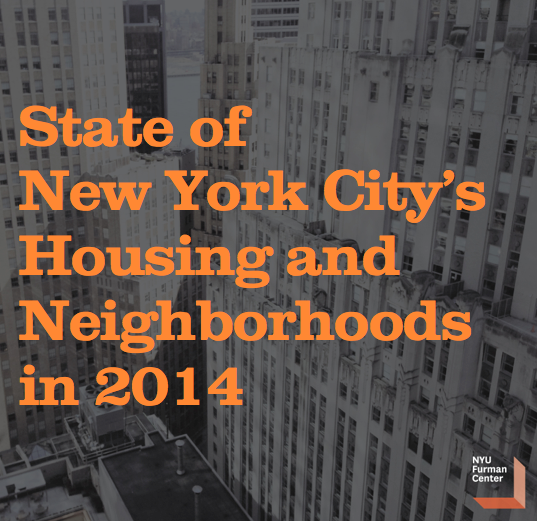
State of NYC’s Housing & Neighborhoods in 2014: City-Wide Analysis

The State of New York City’s Housing and Neighborhoods in 2014 report, released on May 5th by the NYU Furman Center, provides a compendium of data and analysis about New York City’s housing, land use, demographics, and quality of life indicators for each borough and the city’s 59 community districts.
The report is presented in three parts: Part I: Focus on Density, Part II: City-Wide Analysis, and Part III: City, Borough, and Community District Data.
In Part II: City-Wide Overview, the report provides a broad, longitudinal analysis of the city's housing and neighborhoods. Below are the key findings from this analysis:
LAND USE & THE BUILT ENVIRONMENT
- The city approved more units for construction in 2014 than 2013, which were primarily in large projects with 50 units or more. However, the number of approved units remained below that of the mid-2000s. Permitting activity was concentrated in Manhattan, parts of Brooklyn, and Long Island City.
HOMEOWNERS & THEIR HOMES
- Home prices for all property types in each borough rose in 2014 over 2013 levels, marking the third consecutive year that prices have increased. Housing prices have surpassed pre-recession peaks in both Manhattan and Brooklyn.
- Foreclosure filings fell 18% from 2013 to 2014. However, the total number of properties receiving foreclosure filings was still significantly elevated compared to early 2000s levels. The number of total filings in 2014 was close to double the number of filings in 2000.
RENTERS & THEIR HOMES
- In the past eight years, rent increases have far surpassed income growth. Between 2005 and 2013, median rent increased by nearly 12%, while median income of renter households increased by only 2.3% as measured in real terms.
- In 2013, median asking rent for an NYC apartment was $2,900 —more than double the median rent paid by all renters in the city. The highest median asking rents for apartments on StreetEasy were in Manhattan and neighborhoods close to Manhattan. Eight neighborhoods had median asking rents above $3,000.
RESIDENTS
- Between 2000 and 2013, the share of the working age population over 18 grew, while the population below 18 declined. The share of working age population grew the most—nearly two percentage points—reaching 66% of the city’s population in 2013. Meanwhile, the share of children under 18 in the city declined from 24.2% of the city’s population in 2000 to 21.2% in 2013.
- New York City grew more diverse. Between 2000 and 2013, the city’s Asian and Hispanic population shares increased, while the city’s white and black population shares decreased. The share of Asian residents grew the most, from 9.7% in 2000 to 13.4% in 2013. There was also a slight increase in the city's share of foreign-born residents, which grew from 35.9% of the city’s population in 2000 to 37% in 2013.
NEIGHBORHOOD SERVICES & CONDITIONS
- Indicators of school performance and public safety continue to improve citywide, though wide disparities persist across neighborhoods. The share of high school students who graduate on time increased by 10 percentage points between 2005 and 2014. However, significant disparities remain between boroughs. In Staten Island, more than three-quarters of the Class of 2014 graduated on time, while less than 55% in the Bronx received a diploma on time.
- The city’s serious crime rate remained relatively unchanged between 2013 and 2014. Serious crime rates have remained steady in recent years following a dramatic decline over the past two decades.
- More New Yorkers are commuting without a car. Between 2000 and 2013, the share of New Yorkers commuting without a car decreased six percentage points. The share of bicycle commuters increased slightly (0.8%); however, the bulk of this increase in car-free commuters came from the growth in the share of commuters using public transit.
* * *
SURVEY:We appreciate your feedback on the quality and usability of our State of New York City's Housing and Neighborhoods report. Please take a few minutes to fill out this short survey and provide your feedback so we may continue to improve the report. Take the survey >>
REPORT: The State of New York City's Housing and Neighborhoods in 2014 report is now available for download.
MEDIA: Read the press release (PDF); contact: Shannon Moriarty, sm4901@nyu.edu


